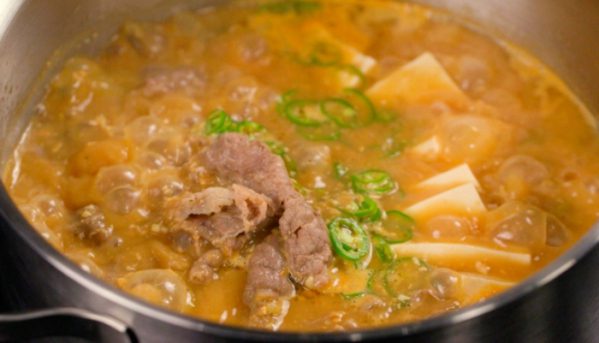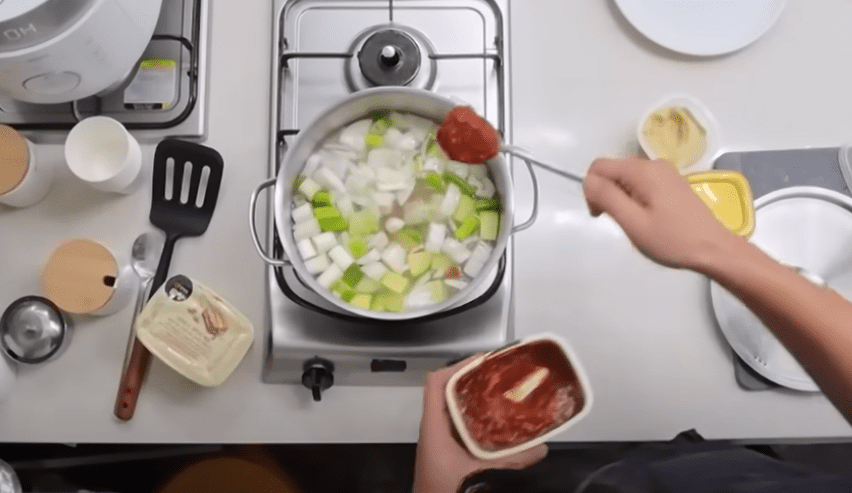Korean Soybean Paste Stew(doenjang‑jjigae), Lifetime Doenjang Jjigae Recipe
Korean Soybean Paste Stew
This Korean doenjang jjigae recipe is so simple and delicious that you’ll use it for a lifetime.
With just water and vegetables, you can create a deep, rich flavor that rivals restaurant-quality
Korean soybean paste stew.
The secret lies in the golden ratio of doenjang to ssamjang and one surprising ingredient that elevates the entire dish.

1. Why This Korean Soybean Paste Stew Recipe Works (Doenjang Jjigae)
1-1. Simple Water-Based Method
This Korean Soybean Paste Stew recipe requires no complicated stock preparation. Starting with plain water, the natural sweetness and deep flavors from the vegetables create a rich, satisfying stew.
Even cooking beginners can master this recipe with minimal risk of failure. Once you learn this method, you’ll have a reliable Korean comfort food recipe for life.
1-2. The Secret Ingredient
The key to this exceptional doenjang jjigae recipe is vinegar. While it may seem unusual, this small addition gives
the stew a special “edge” – the sourness cooks off during boiling, leaving only enhanced umami flavors behind,
much like ginger or cooking wine enhances other dishes.

2. Ingredients (Serves 4)
2-1. Main Ingredients
Vegetables
- Potatoes: Cut into thumb-sized pieces
- Onion: Half an onion, quartered into bite-sized pieces
- Zucchini: About 1/3 of a zucchini, cut into bite-sized pieces
- Green onions: Cut into 1cm thick slices
- Korean chili peppers: To taste
- Tofu: Half a block
- Beef brisket (chadolbagi): 200g
2-2. Seasoning
- Water: 1L (5 cups)
- Doenjang (Korean soybean paste): 3 tablespoons (heaping)
- Ssamjang (Korean seasoned paste): 1 tablespoon
- Minced garlic: 1 tablespoon
- Coarse salt: 1/3 tablespoon
- Vinegar: 1/2 tablespoon
💡 Golden Ratio Tip:
Remember the ratio for 1L water – doenjang 3 : ssamjang 1. This proportion works perfectly for larger batches too!
3. Step-by-Step Cooking Instructions
3-1. Prepare Ingredients
Cut all vegetables into uniform bite-sized pieces. Potatoes should be thumb-sized, onions and zucchini cut to
similar dimensions.
Slice green onions into 1cm pieces.
Having all ingredients prepped beforehand makes the cooking process much smoother.
3-2. Boil Water and Add Vegetables
Bring 1L of water to boil in a pot over high heat. Once boiling, add all prepared vegetables
(potatoes, onion, zucchini, green onions) at once.
While traditionally potatoes are added first, this simplified method works perfectly for easy cooking.
3-3. Add Seasonings
After adding vegetables, add minced garlic (1 tablespoon) and coarse salt (1/3 tablespoon).
Then add doenjang (3 tablespoons) and ssamjang (1 tablespoon).
When the broth starts bubbling vigorously, reduce to medium heat and add vinegar (1/2 tablespoon).
Cover and simmer for at least 10 minutes to extract deep flavors from the vegetables.
3-4. Final Additions
After simmering for 10+ minutes, add tofu (half block), beef brisket (200g), and chili peppers. The beef doesn’t need
pre-cooking – adding it raw at the end creates tender, shabu-shabu-like texture while releasing flavorful oils
into the broth.
Cover and simmer for 3 more minutes. Your authentic Korean doenjang jjigae is ready!
4. Essential Tips for Success
4-1. The Golden Ratio
Water 1L : Doenjang 3 : Ssamjang 1 – memorize this ratio! You can scale it up for larger quantities while maintaining
the perfect flavor balance.
The ssamjang is crucial for achieving restaurant-quality taste at home. Don’t skip this ingredient.
4-2. Timing Matters
Simmer vegetables for at least 10 minutes to develop natural sweetness and depth. The beef brisket only needs 3 minutes – longer cooking makes it tough.
Vinegar should be added when the broth is actively bubbling to ensure the sourness cooks off properly.
5. Serving and Storage
5-1. Best Pairings
Serve hot with steamed rice and traditional Korean side dishes like kimchi, seasoned spinach, or stir-fried anchovies. The mild, savory flavor of doenjang jjigae complements salty and fermented sides perfectly.
5-2. Storage Tips
Store leftovers in the refrigerator for 2-3 days. When reheating, add a little water and bring to a boil. Remove tofu before storing as it can break apart during reheating.
6. Recipe Variations
6-1. Seasonal Vegetables
Adapt this doenjang jjigae recipe with seasonal vegetables: spring herbs like shepherd’s purse, summer squash, or autumn radish. The basic seasoning ratio remains the same.
6-2. Protein Alternatives
Replace beef brisket with pork belly, clams, or other seafood. Each protein adds its unique flavor while the fundamental recipe stays consistent.
7. Troubleshooting
7-1. Avoiding Common Mistakes
Dissolve doenjang paste thoroughly to prevent lumps. Stir well while simmering. Control heat properly – high heat initially, then medium heat for gentle simmering.
7-2. Adjusting Flavor
Taste and adjust at the end. Add more salt or doenjang if too bland, or dilute with water if too salty. Extra garlic or
green onions enhance the aroma.
This lifetime doenjang jjigae recipe, inspired by Korean actor Ryu Soo-young (known as “Teacher Eonam”),
proves that simple ingredients and proper technique can create extraordinary Korean comfort food.
Master this golden ratio and technique, and you’ll have a reliable recipe that brings authentic Korean flavors to
your table anytime!
If there’s anything about Korea you’re curious about,
feel free to leave a comment or contact me through the blog.
I’ll pick the best topics and post them here for everyone to enjoy!
Wishing you a beautiful and joyful day today.
[Follow the thread]







